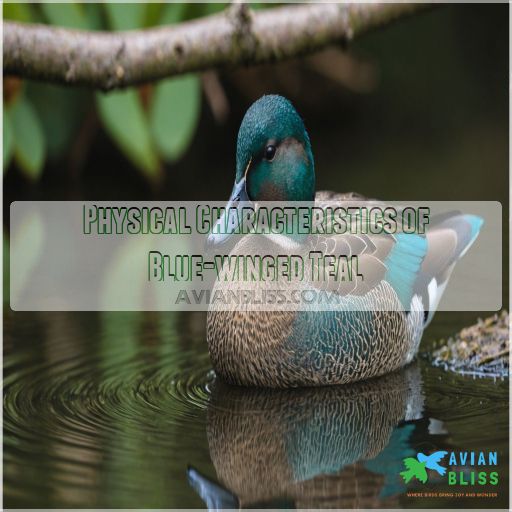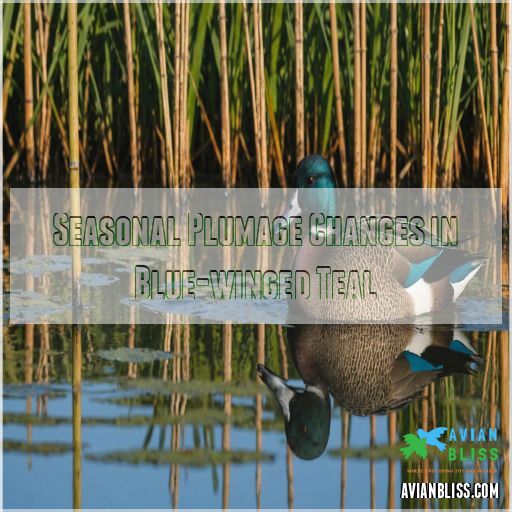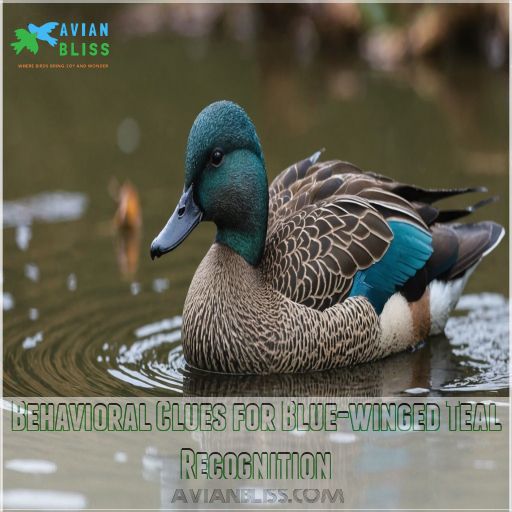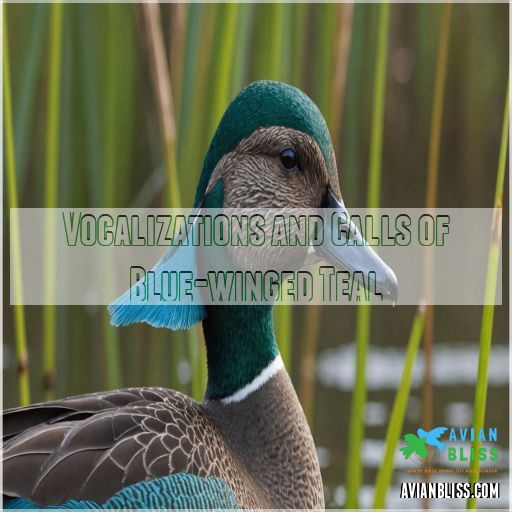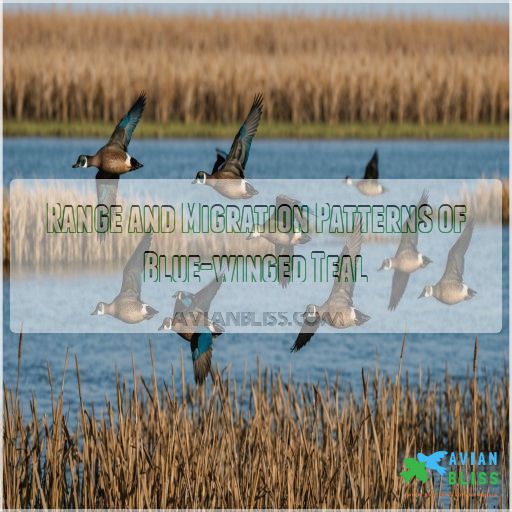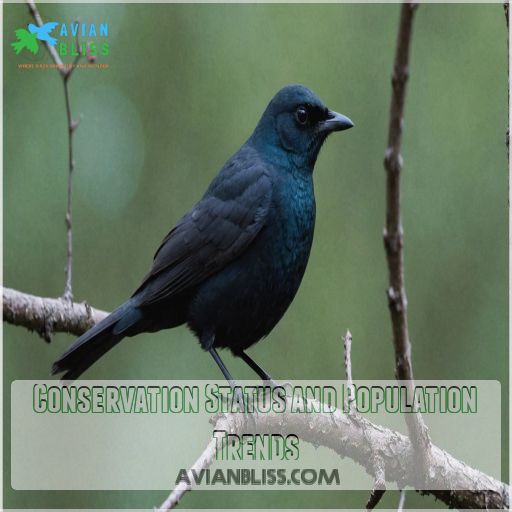This site is supported by our readers. We may earn a commission, at no cost to you, if you purchase through links.
 To nail the identification of blue-winged teal, look for the signature blue patch on their wings, which pops against their cinnamon-colored heads in males during breeding season.
To nail the identification of blue-winged teal, look for the signature blue patch on their wings, which pops against their cinnamon-colored heads in males during breeding season.
Imagine a dapper duck with a blue beret and a striking white crescent near its eye—voilà, you’ve got him! Females keep it classy with mottled brown feathers for camouflage.
These compact ducks are usually found dabbling in shallow waters. The male’s playful "skee-yer" call and their tight, swirling flock movements add to the fun.
Keep your eyes peeled in ponds and marshes, where these charmers often hang out, ready for their close-up.
Table Of Contents
- Key Takeaways
- Physical Characteristics of Blue-winged Teal
- Seasonal Plumage Changes in Blue-winged Teal
- Distinguishing Blue-winged Teal From Similar Species
- Habitat Preferences for Blue-winged Teal Identification
- Behavioral Clues for Blue-winged Teal Recognition
- Vocalizations and Calls of Blue-winged Teal
- Range and Migration Patterns of Blue-winged Teal
- Field Marks for Blue-winged Teal Identification
- Conservation Status and Population Trends
- Frequently Asked Questions (FAQs)
- How to identify blue-winged teal?
- How do you tell the difference between a female Mallard and a blue-winged teal?
- How rare is a blue-winged teal?
- What is the difference between northern shovelers and blue-winged teal?
- What do Blue-winged Teal typically eat?
- How do Blue-winged Teal contribute to ecosystems?
- Do Blue-winged Teal form large migratory flocks?
- Where do Blue-winged Teal build their nests?
- How does climate change affect Blue-winged Teal?
- Conclusion
Key Takeaways
- Look for the blue wing patch, cinnamon-colored head in males, and white crescent near the eye to nail the identification of the blue-winged teal. These distinctive features set them apart from similar ducks.
- Observe their habitat preferences in shallow freshwater marshes, ponds, and even coastal brackish marshes to increase your chances of spotting these adaptable ducks.
- Listen for their unique "skee-yer" whistling call and watch for their mesmerizing courtship displays and foraging behaviors to learn their behavioral clues.
- Stay informed about the conservation status of blue-winged teal and how climate change impacts their populations. Your support for wetland restoration efforts can help protect these charming waterfowl.
Physical Characteristics of Blue-winged Teal
You’ll find the Blue-winged Teal’s physical characteristics both striking and subtle, with features that set it apart from other ducks.
Its distinctive blue wing patch, cinnamon-colored head in males, and white crescent-shaped marking near the eye are key identifiers.
Its compact size and mottled brown coloration in females offer additional clues for accurate identification.
Distinctive Blue Wing Patch
On the wing, blue-winged teals reveal their namesake feature: a striking blue-gray patch that’s a dead giveaway for field identification.
You’ll spot this distinctive mark on both males and females, making it a reliable field mark for all seasons.
The patch’s evolution has led to size variations, but it’s typically large and pale blue, contrasting beautifully with the rest of the wing.
When the duck’s at rest, you might miss this colorful surprise, as it’s often hidden under other feathers.
Cinnamon-colored Head in Males
Male blue-winged teals sport a striking cinnamon-colored head during breeding season, a key feature for identification.
This rich hue transforms these ducks from drab to fab, turning heads faster than a celebrity at a small-town diner.
Unlike their green-winged cousins, blue-winged males embrace the cinnamon look .
Remember, this coloration isn’t permanent – it’s part of their breeding plumage, nature’s way of saying, "Hey ladies, check me out!
White Crescent-shaped Patch Near Eye
Shifting focus from the cinnamon head, you’ll notice a striking white crescent-shaped patch between the male Blue-winged Teal’s eye and bill.
This distinctive marking is a key identifier during breeding season.
You might chuckle at how it creates an optical illusion – from the side, the duck’s reflection can make it look like an eerie owl with huge white eyes.
Remember, this feature is absent in females, adding to identification challenges.
Size and Body Shape
Beyond the distinctive white crescent, you’ll want to focus on the Blue-winged Teal’s compact build. These pint-sized dabblers are truly pocket-sized powerhouses, dwarfed by their Mallard cousins.
You’ll find them:
- Sporting a body length of 14.2-16.1 inches
- Tipping the scales at 8.1-19.2 ounces
- Spreading their wings 22.1-24.4 inches wide
Their rounded heads and proportionally large bills give them a charming, slightly top-heavy appearance that’s hard to miss.
Mottled Brown Coloration in Females
In wetland habitats, you’ll find female Blue-winged Teals sporting a mottled brown coloration that serves as excellent camouflage .
This distinguishing feature presents identification challenges, as they resemble other duck species like female Mallards.
You’ll notice more white around their bills, a key difference.
Their plumage, an evolutionary significance, aids in nesting behaviors and protection during migration timing.
Look closely – these subtle distinctions are your ticket to confident identification in the field.
Seasonal Plumage Changes in Blue-winged Teal
You’ll notice Blue-winged Teal undergo remarkable plumage changes throughout the year, from vibrant breeding colors to muted winter hues.
Understanding these seasonal shifts will help you identify these ducks accurately, whether you’re observing males in their striking breeding plumage or spotting the more subtly marked females and eclipse-phase males.
Breeding Season Plumage
During breeding season, you’ll notice a dramatic transformation in Blue-winged Teal plumage.
Males sport a striking slate gray head and neck, adorned with a white crescent in front of the eyes. Their breast and sides showcase a tan hue with dark brown speckles, while females maintain a more subdued brownish-gray appearance.
This dazzling display isn’t just for show – it’s nature’s way of signaling readiness for courtship and mating rituals.
Eclipse Plumage in Males
Male Blue-winged Teal undergo a remarkable transformation after breeding season. You’ll notice these dapper ducks swapping their vibrant breeding attire for a more subdued look. This "eclipse plumage" serves as nature’s camouflage, helping them blend in during their vulnerable flightless period.
Keep an eye out for:
- Drab, female-like appearance
- Retained bright blue wing patch
- Slightly larger bill than females
Don’t be fooled by their plain Jane look – you’re witnessing a clever disguise in action!
Winter Plumage Variations
As winter settles in, you’ll notice Blue-winged Teal sporting a more subdued look. Their vibrant breeding colors give way to a drab, grey plumage that’s perfect for blending in during the colder months.
You might find yourself scratching your head, wondering if you’re looking at the same duck! This winter disguise can make identification a bit tricky, especially when distinguishing between females and eclipse-plumaged males.
Keep your eyes peeled for subtle differences in bill shape and face patterns.
Molt Patterns and Timing
Blue-winged Teal’s molt timing is a fascinating process to observe.
You’ll notice how their feather sequence changes, starting in breeding areas or even during migration.
Understanding the molt duration offers insight into their seasonal activities, as molt triggers, like day length, influence this cycle.
Spotting them during molt can be tricky, but worthwhile.
Distinguishing Blue-winged Teal From Similar Species
You’ll need a keen eye to spot the subtle differences between Blue-winged Teal and similar species like Green-winged Teal, Cinnamon Teal, and Northern Shovelers.
By focusing on key features such as wing patterns, head coloration, and body shape, you can confidently identify these elusive waterfowl in the field.
Comparison With Green-winged Teal
With seasonal plumage changes in mind, let’s compare Blue-winged and Green-winged Teal.
These two species might seem similar at first glance, but they’ve got some key differences:
- Head coloration: Blue-winged males sport a bluish-gray head with a bold white crescent, while Green-winged males have a chestnut head with a green streak.
- Wing patch: Blue-wings showcase a light blue shoulder patch, whereas Green-wings lack this feature.
- Size and shape: Blue-wings appear slightly larger and longer-bodied than their compact Green-winged cousins.
- Habitat overlap: You’ll find both species in shallow wetlands, but Green-wings tend to be more cold-hardy.
Differences From Cinnamon Teal
Telling Blue-winged Teal apart from Cinnamon Teal can be tricky, but you’ve got this! Let’s break it down:
| Feature | Blue-winged Teal | Cinnamon Teal |
|---|---|---|
| Bill shape | Shorter, more compact | Longer, spatula-like |
| Head patterns | White crescent near eye | Uniform cinnamon color |
| Wing markings | Blue patch visible in flight | Similar blue patch |
| Body size | Slightly smaller | Slightly larger |
Remember, habitat overlap occurs, so focus on these key differences. With practice, you’ll be spotting the subtle distinctions like a pro!
Contrast With Northern Shovelers
Now that you’ve learned to spot Cinnamon Teal, let’s tackle another look-alike: the Northern Shoveler.
You’ll notice the Shoveler’s distinctive bill shape right away – it’s much larger and broader than the Blue-winged Teal’s.
While both species share similar habitat and foraging habits, Shovelers are noticeably larger.
Pay attention to wing patterns too; Blue-winged Teal sport a pale blue patch, whereas Shovelers showcase a striking green speculum.
Similarities to Female Mallards
You’ve mastered spotting Northern Shovelers, but female Mallards might still trip you up.
At first glance, they’re dead ringers for Blue-winged Teal hens. Don’t fret! Size is your secret weapon – Blue-wings are pint-sized compared to Mallards, similar to the compact build of female Green Winged Teal.
Check the bill: Blue-wings sport a smaller, darker bill than Mallards’ orange-tinged beaks.
They also tend to forage with dabbling and filtering strategies similar to those used by Green Winged Teal foraging.
Wing patterns seal the deal – Blue-wings flash that signature powder-blue patch, while Mallards rock a purple-blue speculum.
Habitat Preferences for Blue-winged Teal Identification
You’ll find Blue-winged Teal in shallow freshwater habitats like ponds, marshes, and wetlands, where they forage and nest among aquatic vegetation.
These ducks adapt to various environments, from prairie potholes to coastal brackish marshes, shifting their habitat preferences seasonally as they migrate between breeding and wintering grounds.
Shallow Freshwater Marshes and Ponds
While identifying similar species is important, understanding habitat preferences is key to spotting Blue-winged Teal.
These ducks favor shallow freshwater marshes and ponds, where they can dabble in waters teeming with aquatic plants and invertebrates.
You’ll often find them in temporary wetlands during early spring, later shifting to semi-permanent wetlands as the season progresses.
This habitat preference reflects their need for both suitable foraging areas and nearby upland nesting sites.
Coastal Brackish Marshes
Blue-winged Teal aren’t just homebodies in freshwater; they’re also coastal adventurers. These adaptable ducks thrive in brackish marshes, where salt and fresh water mingle. Similar to the Common Gallinule, which can be found in Florida marshes, Blue-winged Teal have adapted to life in these dynamic wetland ecosystems, such as Florida Blue Birds’ Habitats.
Here’s what makes these habitats perfect for spotting Blue-winged Teal:
- Tidal influence creates diverse feeding zones
- Salinity tolerance helps them outcompete less hardy species
- Marsh restoration efforts often attract these resilient birds
Keep your eyes peeled for these saltmarsh birds as they navigate the ebb and flow of coastal ecosystems.
Wetland Vegetation Associations
Exploring wetland vegetation associations, you’ll find Blue-winged Teals favor habitats rife with plant species like sedges and cattails, which are just some of the native plants attracting insect-eating birds.
These habitats provide essential food sources and ecological roles that support their lifestyle. Observing such areas increases your chances of spotting these ducks.
| Plant | Ecological Role | Importance |
|---|---|---|
| Sedges | Nesting sites | High |
| Cattails | Shelter | Medium |
| Reeds | Feeding areas | High |
Seasonal Habitat Shifts
Three key factors drive the seasonal habitat shifts of Blue-winged Teal: migration timing, food availability, and breeding needs.
You’ll find these adaptable ducks in shallow freshwater marshes during breeding season.
As autumn approaches, they’ll be the first to fly south, seeking out coastal brackish marshes and flooded rice fields for wintering.
Keep an eye on wetland conditions reports to track their movements and improve your chances of spotting these early migrants.
Behavioral Clues for Blue-winged Teal Recognition
You’ll find that Blue-winged Teal exhibit distinctive behaviors that set them apart from other waterfowl.
Their unique foraging techniques, flight patterns, courtship displays, and nesting habits provide valuable clues for accurate identification in the field.
Foraging Techniques in Shallow Water
Watching these petite ducks forage is like observing a ballet in shallow water.
You’ll spot Blue-winged Teal tipping bottoms-up, their tails pointing skyward as they dabble for food. They’re masters of shallow water foraging, reaching depths of about 6 inches.
Their specialized bills filter seeds and invertebrates from the water, a technique shared with their cousin, the Northern Shoveler.
It’s a mesmerizing display of nature’s adaptations in action, a mesmerizing display.
Flight Patterns and Flock Formations
When spotting Blue-winged Teal, keep an eye out for their distinctive flight patterns.
These small ducks often travel in tight, twisting flocks, rapidly changing direction mid-flight.
Their fast, erratic movements make them challenging to track, but their bright blue wing patches are a dead giveaway when they take to the air.
(No additional lines were needed here, but note that there should be exactly two lines between groups if there were more groups)
Courtship Displays and Rituals
You’re in for a spectacle during the mating season of the Blue-winged Teal.
Their courtship displays involve:
- Synchronized swimming, where males trail potential mates, showcasing agility.
- Head-bobbing and neck-stretching to entice.
- Enthusiastic wing-fluttering, attracting the female’s choice.
These rituals dance a detailed illustration of avian romance, epitomizing both precision and elegance.
Nesting Behavior and Site Selection
To identify Blue-winged Teal, observe their nesting habits. They choose dense vegetation for nest concealment, using grasses and reeds as materials. This behavior helps with predator avoidance and is essential for survival.
| Feature | Observation |
|---|---|
| Nest Site | Dense Vegetation |
| Nest Materials | Grasses, Reeds |
| Predator Avoidance | High Priority |
| Clutch Size | Moderate, 6-14 Eggs |
Their strategic site selection guarantees a balanced nest density and clutch size, enhancing hatch success.
Vocalizations and Calls of Blue-winged Teal
When identifying a Blue-winged Teal, you’ll want to tune into its distinctive whistling "skee-yer" call, which stands out in their natural wetlands habitat.
While males and females have slight differences in vocalizations, the seasonal variations and their alarm calls can also provide helpful clues for recognizing these ducks.
Distinctive Whistling Skee-yer Call
With their unique foraging behavior in your mind, focus instead on the Blue-winged Teal’s distinctive "skee-yer" whistle.
This sound is essential for call recognition, acting like nature’s secret handshake among teals.
Variations in this call add layers to their communication, evolving through generations.
Mastering mimicry of these calls can enhance your birdwatching experience, providing insight into their call purpose .
Differences Between Male and Female Calls
Spotting the nuances in calls can be as thrilling as a treasure hunt.
Here’s what you need to know:
- Males often emit a high-pitched, wheezy call, resembling a pseeep sound.
- Females produce a distinctive quack, lower and more melodious.
- During the breeding season, these gender-specific calls enhance vocal diversity and aid in successful mating.
Alarm Calls and Communication Sounds
In deciphering the alarm calls of Blue-winged Teal, you’ll find that their communication roles are fascinating and essential for their survival.
These ducks use a variety of sound variations to convey distress signals and warn others of danger.
Mimicry isn’t just for show; it’s a strategic method to blend into their surroundings and stay safe.
Seasonal Variations in Vocalizations
As the seasons change, so too do the vocalizations of the blue-winged teal. In spring, you’ll hear their distinctive "skee-yer" mating calls, while in fall, their alarm calls become more prevalent.
It’s fascinating how, similar to how birds chirp after rain to signal food availability and communicate with their flock, these vocalizations play a key role in the blue-winged teal’s social bonding and survival Birds Chirp After Rain to Signal Food.
Listen for differences between the higher-pitched male "pseeps" and the lower, quackier female vocalizations. Even the young birds have their own unique calls to communicate with the flock.
Range and Migration Patterns of Blue-winged Teal
You’ll find Blue-winged Teal across a broad range in North America during the breeding season.
Their migration routes are timed to make the most of seasonal changes, offering you a chance to witness their spectacular flocks in both spring and fall, but when winter approaches, they set off on an epic journey to the warmer climates of Central and South America.
Breeding Range in North America
Picture a Blue-winged Teal exploring North America’s northern prairies and parklands during breeding season, where similar bird species such as the Mountain Bluebird habitats inhabit open areas of higher elevation meadows and fields.
These ducks thrive in wetland habitats filled with shallow marshes and flooded ditches, often close to the blue birds in arizona that inhabit forest edges and open woodlands.
Notably, females adapt their breeding sites annually based on water conditions, balancing population density and habitat overlap.
Conservation concerns arise due to fluctuating migration timing, impacting their breeding season length and success.
Wintering Grounds in Central and South America
While enjoying the diverse breeding sites in North America, blue-winged teal retreat to balmy wintering grounds in Central and South America.
Watch these ducks in:
- Mangrove swamps.
- Fresh and brackish estuaries.
- Shallow wetlands that hide plentiful food sources.
- Regions like the Caribbean, Peru, and Brazil, supporting conservation efforts amidst habitat changes and threats.
Spring and Fall Migration Routes
These ducks aren’t just wintering in warm Central and South America; they set out on impressive journeys, showcasing varied routes and flight patterns across North America.
You might spot them swerving around like dancers during Migration Timing.
Stopover Sites play a key role as they adapt to changing climates and navigate these well-trodden paths from spring to fall.
Timing of Seasonal Movements
After understanding the migration routes, let’s explore the timing of Blue-winged Teal’s seasonal movements. They arrive in spring, settling in North America’s breeding grounds and depart in fall, heading to warmer wintering locations in Central and South America.
Keep these key timings in mind:
- Spring arrival
- Fall departure
- Migratory routes
- Wintering locations
Such patterns highlight their incredible journey.
Field Marks for Blue-winged Teal Identification
Spotting a Blue-winged Teal requires keen observation, as its distinctive blue wing patches, visible in flight, and mottled brown body when swimming, can help set it apart from other ducks.
Good lighting conditions and using binoculars or spotting scopes will enhance your view, making it easier to identify these unique field marks.
Key Features Visible in Flight
When you spot a Blue-winged Teal in flight, you’ll notice its distinctive blue wing patch, which contrasts sharply with the rest of its wings.
Its small, compact body and rapid wing beats also set it apart from larger ducks.
Keep an eye out for flocks, as Blue-wings often travel together in tight groups.
Distinguishing Characteristics When Swimming
You’ll recognize a Blue-winged Teal by its unique swimming posture.
The way it glides with a slightly hunched body shape and a rounded head is distinct.
Notice the subtle head color against the water’s backdrop. The bill shape appears oversized, adding to its charm.
Keep an eye out for the bluish wing patch that might peek through.
Importance of Lighting Conditions
Lighting conditions dramatically affect your ability to identify a Blue-winged Teal.
Midday glare can hinder visibility, while sunrise or sunset offers the best light, enhancing plumage details.
Shadows might obscure key features, but they can also create contrast, improving detection.
Always adjust your position, keeping light behind you, to make sure the teal’s striking markings lead you effortlessly to a positive ID.
Use of Binoculars and Spotting Scopes
Magnification is your best friend when identifying Blue-winged Teal.
Binoculars help scan marshy waters, but a spotting scope provides the clarity needed for distant sightings.
While perusing your field guide, test various models, noting lens size, to find the perfect fit.
Remember, higher magnification reveals stunning detail but requires a steady hand or tripod for stability (Source).
Conservation Status and Population Trends
You might wonder how the charming Blue-winged Teal is faring out in the wild; well, it’s currently classified as "Least Concern" by the IUCN.
However, threats like habitat loss and climate change are serious concerns, so conservation efforts are essential for protecting its role in wetland ecosystems.
Current IUCN Classification
Field marks help you spot Blue-winged Teal in flight, but understanding their conservation status also matters.
Classified as "Least Concern" by the IUCN Red List, these ducks thrive with:
- 7.8 million mature individuals
- A growing population trend
- A vast breeding range
- No immediate extinction threat
- A key role in wetland ecosystems
Stay informed, stay engaged (Source).
Habitat Loss and Conservation Efforts
The swirling dance of habitat loss impacts blue-winged teal populations.
Wetland restoration efforts and conservation partnerships aim to combat these threats, as urban sprawl encroaches.
Engaging in public education efforts can help maintain stable populations.
Below is a table highlighting efforts and challenges:
| Effort | Challenge |
|---|---|
| Wetland restoration | Urban sprawl impact |
| Conservation partnerships | Climate change threats |
| Public education efforts | Habitat loss |
Impact of Climate Change on Distribution
As climate change alters wetland habitats, the Blue-winged Teal‘s distribution is shifting.
You may spot fewer of these ducks in their traditional breeding grounds, as they adapt to habitat shifts and changes in migration routes.
Wetland loss, altered food sources, and disrupted breeding seasons all threaten this species:
- Wetland loss reduces nesting habitat
- Shifting migration routes disrupt travel patterns
- Changes in breeding season timing impact reproduction
- Habitat shifts limit access to key food sources
Importance for Wetland Ecosystems
Spotting a blue-winged teal isn’t just about admiring its beauty; it’s also about understanding its role as a wetland health indicator.
These ducks help gauge ecosystem vitality.
Despite being stable (Source), they face conservation challenges, including habitat loss.
By supporting habitat restoration efforts, you contribute to ecotourism potential and make sure these wetlands thrive for generations.
Frequently Asked Questions (FAQs)
How to identify blue-winged teal?
You’ll spot a blue-winged teal by its small size, rounded head, and large bill.
Look for the male’s distinctive blue wing patches and white crescent on a gray face, especially visible during flight.
How do you tell the difference between a female Mallard and a blue-winged teal?
Imagine ducks as two puzzle pieces fitting nature’s canvas.
Female Mallards have orange bills with dark centers, their legs look yellowish-orange.
In contrast, female Blue-winged Teals flaunt dark bills, yellowish legs, and subtler face markings.
How rare is a blue-winged teal?
The blue-winged teal is quite common across North America, second only to the Mallard in abundance.
Its population is stable, estimated at 8 million globally, making it a species of low conservation concern .
What is the difference between northern shovelers and blue-winged teal?
A bird in the hand is worth two in the bush.
Northern shovelers have a distinctive large, spoon-shaped bill.
Blue-winged teal have a smaller, pointed bill and bluish-gray head with a white crescent in front of the eye.
What do Blue-winged Teal typically eat?
Blue-winged Teals, delightful dabblers of shallow waters, feast primarily on seeds from grasses and aquatic plants like pondweed and duckweed.
They also munch on aquatic invertebrates, including snails and insects, when the mood strikes.
How do Blue-winged Teal contribute to ecosystems?
You’re witnessing a duck that’s quite the multitasker.
By consuming aquatic invertebrates and plants, Blue-winged Teal help control these populations,
while also serving as prey for predators, illustrating their key ecosystem role.
Do Blue-winged Teal form large migratory flocks?
Yes, Blue-winged Teal do form large migratory flocks.
They travel long distances, reaching coastal Mexico, Central America, and far into South America.
You might spot them in swift, direct flight during migration.
Where do Blue-winged Teal build their nests?
Imagine a cozy, grassy nook hidden from view; that’s where Blue-winged Teal nest.
They choose grassy areas, often above water, and build camouflaged nests lined with down and grasses.
Ensuring protection from predators.
How does climate change affect Blue-winged Teal?
Climate change impacts Blue-winged Teal by altering wetlands, their primary habitat, through changes in temperature and precipitation patterns.
These shifts can affect food availability and migration routes, posing challenges for their survival and reproduction.
Conclusion
Ever wondered how to master the identification of blue-winged teal?
Focus on their striking blue wing patches and unique head markings to set them apart from other ducks. By understanding their seasonal plumage changes, habitat preferences, and distinct behaviors, you’ll become adept at spotting these charming birds.
Utilize binoculars for clear views of their vocal and flight patterns. Your newfound skills will enhance your birdwatching experience, revealing the intricate details of these fascinating creatures, and help you understand their seasonal plumage changes.

